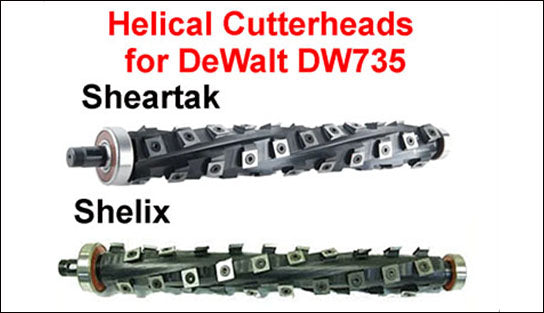
Sheartak vs Shelix: Honest Spiral Cutterhead Comparison (2025)
Introduction
If you’ve been researching spiral (helical) cutterheads, you’ve probably seen comparisons online—like the one at Ralph’s Way—that claim one brand is clearly better than the other. The truth is more nuanced. Both Sheartak and Shelix cutterheads represent a massive improvement over traditional straight knives, but each has its own strengths.
This article aims to clear the air with a balanced, experience-driven comparison so you can make the right choice for your workshop.
What They Have in Common
Before diving into differences, let’s establish the basics:
-
Both use carbide inserts arranged in a spiral pattern.
-
Both reduce tear-out compared to straight blades, especially on figured hardwoods.
-
Both lower noise levels compared to traditional knives.
-
Both save maintenance time since inserts can be rotated or replaced individually.
In other words, whichever you choose, you’re already making a huge upgrade.
Key Differences
1. Carbide Inserts
Some sources claim Shelix uses “K10 solid carbide” while Sheartak uses “sintered carbide.” In reality, both use high-quality tungsten carbide inserts manufactured through a sintering process (that’s how carbide is made). The difference comes down to geometry, sharpness, and availability of inserts, not vague labels.
2. Noise
Shelix is often described as “quieter,” with some even quoting “50% less noise.” But no independent test confirms this number. In practice, machine condition, feed speed, and depth of cut matter more than brand. Both are quieter than straight knives, but don’t expect dramatic differences between Sheartak and Shelix.
3. Finish Quality
Both deliver smoother results than straight blades. That said, spiral cutterheads can leave very slight scalloping, which most woodworkers sand out with 120-grit in seconds. Some users find Shelix has a marginally smoother cut, but the difference is subtle and often irrelevant after sanding.
4. Motor Load
One factor rarely discussed is power draw. With multiple inserts engaged at once, spiral cutterheads naturally demand more from the motor. On smaller planers, this can cause bogging regardless of whether it’s Sheartak or Shelix. The takeaway: cutterhead choice helps, but motor size still limits your machine.
5. Price
-
Sheartak: More affordable, typically 20–40% less than Shelix.
-
Shelix: Higher upfront cost, justified partly by branding and U.S. distribution.
For many hobbyists, the price gap alone makes Sheartak the practical choice.
Real User Experiences
Across woodworking forums and Reddit, here’s what actual users report:
-
On Sheartak:
“Finish quality is excellent. Tear-out is nearly gone. Rotating inserts is much easier than dealing with long knives.” -
On Shelix:
“I’ve run thousands of board feet through mine and never had to rotate a single insert. Finish is silky smooth right off the planer.” -
On Both:
“There is minor scalloping, but nothing a light sanding doesn’t fix. Both are a world ahead of straight blades.”
This shows the difference is not about whether they work—it’s about which aligns better with your needs.
Conclusion
Both Sheartak and Shelix cutterheads deliver excellent results, far surpassing traditional straight knives in durability, noise reduction, and surface quality.
-
Choose Sheartak if you want a cost-effective, reliable upgrade that gets you 90–95% of the way there at a much lower price.
-
Choose Shelix if you’re willing to pay a premium for marginal improvements in smoothness and branding.
Either way, your woodworking will benefit—and the debate should focus less on marketing claims and more on what matters: finding the cutterhead that matches your machine, your budget, and your projects.

Leave a comment